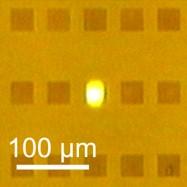Breakthrough by uOttawa researchers sees creation of light-emitting solid carbon from CO2 gas

Credit: University of Ottawa, OSA Optica
A team of researchers at the University of Ottawa has found a way to use visible light to transform carbon dioxide gas, or CO2, into solid carbon forms that emit light. This development creates a new, low-energy CO2 reduction pathway to solid carbon that will have implications across many fields.
We talked to lead author Dr. Jaspreet Walia, Post-Doctoral Fellow in the School of Electrical Engineering and Computer Science at the University of Ottawa, and research lead Dr. Pierre Berini, uOttawa Distinguished Professor and University Research Chair in Surface Plasmon Photonics, to learn more.
Please tell us about your team’s discovery.
Pierre Berini: “We have reduced carbon dioxide, a greenhouse gas, to solid carbon on a nanostructured silver surface illuminated with green light, without the need for any other reagents. Energetic electrons excited on the silver surface by green light transfer to carbon dioxide molecules, initiating dissociation. The carbon deposits were also found to emit intense yellow light in a process known as photoluminescence.”
How did you come to these conclusions?
Jaspreet Walia: “We used a technique known as Raman Scattering to probe the reaction in real time to determine which products, if any, were forming. To our surprise, we consistently observed signatures of carbon forming on the surface, as well as bright and visible yellow light emanating from the sample.”
Why is it important?
Pierre Berini: “Recently, there has been considerable global research effort devoted to developing technologies that can transform CO2 using visible light. Our work not only demonstrates that this is possible, but also that light emitting solid carbon can be formed.”
What are the applications of this discovery in our lives?
Jaspreet Walia: “This fixed pathway for reagent-less CO2 reduction to light emitting solid carbon, driven by visible light, will be of interest to researchers involved in the development of solar driven chemical transformations, industrial scale catalytic processes, and light-emitting metasurfaces.”
“More specifically, with respect to the creation of carbon directly from CO2 gas, our findings will have an impact on research involving plasmon assisted reactions and I would expect the emergence of applications in the oil and gas industries, where catalytic transformations involving carbon-based compounds is a key focus area.”
“Next-generation reactions involving CO2 and light could also lead to other useful outcomes, such as the potential for artificial photosynthesis. Our findings could be used for light control and manipulation at the nanoscale, or to possibility realize flat light sources due to the light-emitting aspect of our discovery. The nanostructured carbon itself could also be used in catalysis.”
“Finally, the wavelength (color) of the light emitted from carbon dots on a silver surface could be very sensitive to the local environment, making it an attractive sensing platform for pollutants, for example.”
Is there anything you would like to add?
Pierre Berini: “We have learned how to form solid carbon deposits that emit light “out of thick air”, in a breakthrough enabled by light-assisted transformation of CO2 gas driven by energetic electrons. The project was entirely driven by curiosity, with no set expectations on outcomes, and benefitted from close collaboration with graduate students Sabaa Rashid and Graham Killaire, as well as Professors Fabio Variola and Arnaud Weck.”
###
The research took place at the uOttawa Centre for Research in Photonics, from January 2020 to present. The paper “Reconfigurable carbon quantum emitters from CO2 gas reduced via surface plasmons” is published in the journal Optica as a memorandum.
Authors:
* Jaspreet Walia (Post-Doctoral Fellow, Department of Electrical and Computer Engineering, University of Ottawa)
* Sabaa Rashid (Master’s Student, Faculty of Engineering, University of Ottawa)
* Graham Killaire (Ph.D. Candidate, Department of Physics, University of Ottawa)
* Fabio Variola (Associate Professor, Department of Mechanical Engineering, University of Ottawa)
* Arnaud Weck (Full Professor, Department of Mechanical Engineering, University of Ottawa)
* Pierre Berini (Distinguished Professor and University Research Chair in Surface Plasmon Photonics. Director of the Centre for Research in Photonics and Director of the CRPuO Nanofab, University of Ottawa)
Media Contact
Justine Boutet
[email protected]
Original Source
https:/
Related Journal Article
http://dx.




